La Cambe
The 320th Antiaircraft Balloon Battalion on Omaha

Barrage balloon being man-handled at Camp Davis, NC.

From Camp Tyson (USA) to Omaha Beach
On August 15, 1941, the announcement was made that Routon, Tennessee had been chosen as the site for the Army's new barrage balloon training center (the original BBTC had been established temporarily at Camp Davis, North Carolina; the postcard shows a balloon being man-handled at Camp Davis). Tyson was to be the only Army post of its kind in America. Construction began on September 4, 1941. The barrage balloon was a new tool of defensive warfare and the camp was established for the express purpose of constructing barrage balloons and training personnel in their deployment and use, an assignment commissioned by the Secretary of War on April 14, 1941.
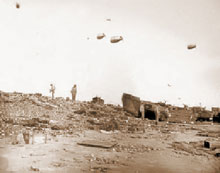
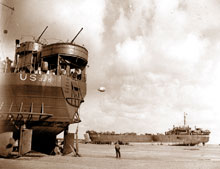
(National Archives and Records Administration Photo No. 80-252797, originally a U.S. Navy photo; available at NavSource.)
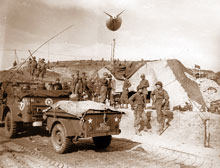
A balloon flown by the 320th protects the E-3 exit at Omaha Beach on D+2 (Easy Red sector).

British LCT's line the Normandy shore, each with a barrage balloon designed to discourage enemy air attack. (From «Coast Guard at Normandy» by Scott T. Price.)
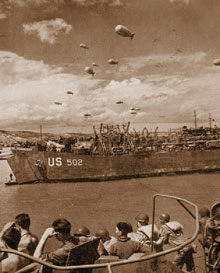
LST 502 beached on Omaha, June 1944. No less than 13 barrage balloons protect the immediate area. Note the LST's open door at left, with a crewman on the ramp. When the tide goes out, the LST will be high and dry and can begin unloading.
The location of the camp was chosen because it was considerably far away from regular air planes and balloon activities would not interfere with peacetime aviation. Much planning, including devising training and operational procedures, was accomplished at Camp Davis while waiting for the new camp to be completed. Antiaircraft defence planners tested and documented the complicated process of handling the winches and cables for the balloons, which could be flown up to altitudes of 10,000 feet.
Power was furnished by gasoline-powered motors which had to be maintained also, and atmospheric conditions had to be evaluated before releasing the balloons. All of the tactics and techniques involving the balloons and their equipment were developed from scratch in 1940-41, after which training manuals were created and training cadres formed. The Coast Artillery formed several «Barrage Battalions» in 1941 and they were deployed in conjunction with AAA guns to defend the oil refineries and storage facilities near Los Angeles in Southern California. However, the balloons were not ready to be fully deployed in time to avert the disastrous surprise attack by the Japanese at Pearl Harbor on December 7, 1941.
Paris and all of Henry County soon became jammed to capacity with workmen. At the peak of employment, a total of almost 8,000 persons were engaged in erecting the camp. Construction peaked at Christmas 1941 and then began to diminish until the camp was completed, on March 14, 1942. On that day, the camp was turned over to the U.S. Army.
The only Black combat unit to take part in the initial D-Day landing
The 320th Antiaircraft Balloon Battalion (VLA) (denoting Very Low Altitude) was the only Black combat unit to take part in the initial D-Day landing on the Normandy coast on June 6, 1944. The barrage balloons seen floating over the beaches of Normandy in June 1944 were the responsibility of this unique unit.
an arm of antiaircraft defence, barrage balloons had a very short lifespan. After the Luftwaffe had been effectively dispatched from European skies, the balloons soon became obsolete. Camp Tyson then became a staging area for troops going overseas, and also as a prisoner-of-war camp for German prisoners captured in North Africa.
«With all the men, tanks, trucks, airplanes, and the tons and tons of supplies being gathered for the invasion, if it hadn't been for the barrage balloons, Britain would have sunk»
Brief history (excerpted from Barrage Balloons for Low-Level Air Defence by Major Franklin J. Hillson, USAF)
It was hoped the barrage balloons would deter invasion by low-flying aircraft. The barrage balloon, filled with lighter-than-air gas, was attached to a steel cable that could be raised or lowered using a motorized winch. In forcing enemy planes to higher altitudes, surprise invasions became less likely and bombing accuracy was hampered as well. The balloons restricted the airspace available to rogue aircraft, channeling their flights into zones protected by ground-based artillery. The cables themselves presented a hazard to pilots, capable of shearing off a passing plane's wings and propellers. At one time, a charge was placed beneath the balloon that would blow when the wing of the plane slid to the top of the cable, with the release of the helium setting the plane on fire. Great Britain had used similar balloons during the last years of World War I and in the early days of World War II thousands of balloons dotted the British skies. LST-325 (left) and LST-388 unloading at Omaha Beach on June 12, 1944 while stranded at low tide during resupply operations. Note the propellers, rudders, and other underwater details of these LSTs, as well as single 40-mm guns and the «Danforth»-style kedge anchor at LST-325's stern. And, of course, the barrage balloon in the distance.
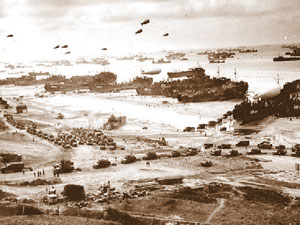
This famous photo shows Omaha Beach secured and dozens of ships unloading, thanks, in part, to the protective canopy of barrage balloons above. (From «Coast Guard at Normandy» by Scott T. Price.)
VLA at Omaha Beach
320th Antiaircraft Balloon Battalion (VLA, or Very Low Altitude) an all African American unit attached to the U.S. First Army brought in barrage balloons in LSTs and LCIs in the third wave at Omaha and set them up on the beach, to prevent Luftwaffe strafing during the early hours of the assault. (Barrage balloons actually caused some serious concern at the Normandy landings, especially in the early hours. Several batteries of long-range German artillery could see these large balloons tethered above ships from several miles inland and were able to bombard those ships that they could not see with a fair amount of accuracy. Many Navy crews cut their balloons loose when it became apparent that the Luftwaffe was not going to be a big factor that day, but the artillery was.) After the beaches were secured, hundreds of balloons were set aloft over ships and shore. All of the barrage balloons flying over Omaha were flown by the African-American troops of the 320th, a little-known fact about the invasion.
In fact, of the U.S.; first Army's Omaha Beach assault forces on D-Day, less than 500 out of 29,714 troops were black. These were one section of the 3275th Quartermaster Service Company and the above-mentioned 320th Antiaircraft Balloon Battalion (VLA) (less one battery). Of the 31,912 U.S. troops landing on Utah Beach, approximately 1,200 were African-Americans and included troops of the remaining battery of the 320th Balloon Battalion, the 582d Engineer Dump Truck Company, the 385th Quartermaster Truck Company, and the 490th Port Battalion with its 226th, 227th, 228th, and 229th Port Companies.
One man in the 320th distinguished himself
One man in the 320th distinguished himself above many others that day. Corporal Waverly B. Woodson, Jr. was still a second-class citizen in terms of the rights he enjoyed as an African-American citizen of the United States. His diminished social and political status in the 1940s America was not reflected by his conduct in action. Serving as a medical corpsman with the 320th Barrage Balloon Battalion, Woodson rode an LST into Omaha Beach and suffered a shrapnel wound when the vessel struck a mine as it approached the landing site. Disembarking while under continuous mortar and machine gun fire, Woodson assisted in establishing an aid station on the beach and remained on continuous duty in treating casualties for the next 18 hours. He then assisted in retrieving and reviving three soldiers who had nearly drowned while leaving a landing craft which had slipped its anchor and drifted into deep water. Woodson was then hospitalized for treatment of the wound he had received the previous day. He was one of the over one million black GIs and WACs who loyally served in the armed forces in defence of their country during World War II.